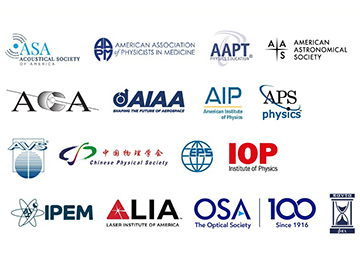
Sixteen academic societies in physics have released a joint statement on sustainable open access.
15 December 2020—A group of 16 international physics organizations today issued a joint statement underscoring the discipline’s historical support for open access (OA) to physics research, and endorsing “any and all OA models that can provide financially sustainable support for author choice and the quality of peer review and publication upon which excellent physics research relies.”
The statement offered a concerted response to policies among some stakeholder groups—in particular, the Rights Retention Strategy of cOAlition S, an alliance of mainly European funders—that seek to overturn subscription-based academic publishing and force a rapid transition to an all-OA scholarly-publishing ecosystem. Such top-down policies, the physics organizations argue, actually threaten the community’s OA efforts by undermining the viability of transitional vehicles such as hybrid subscription–OA publications, and by attempting to “flip” the publishing ecosystem before adequate global financial support is in place to support such a move.
Long OA pedigree
The statement published today stressed the physics community’s bona fides and long history in open-access publishing. That history includes the creation of one of the first, and arguably the best-known, electronic preprint servers, the arXiv, originally launched by the physicist Paul Ginsparg in August 1991.
The physics community, the statement points out, also has been responsible for some of the earliest open-access scholarly journals, including Optics Express, first published by The Optical Society (OSA) in July 1997, and the New Journal of Physics, launched by the Institute of Physics (IOP) in May 1999. And physics research publishers have steadily launched other OA titles in the years since then, including recent “high-impact” OA entries such as OSA’s Optica and the American Physical Society’s Physical Review X.
Also, the statement notes, the physics community has pressed forward with new business models to smooth the transition to open access. These have included so-called transformative agreements with institutions that redirect an increasing share of institutional funds from subscription to open-access publishing, and efforts such as those of the Sponsoring Consortium of Open-Access Publishing in Particle Physics (SCOAP3).
In the wake of these and other efforts, according to the statement from the physics organizations, the number of OA physics articles has expanded at an average annual rate of 25%—even as the number of physics articles overall has grown at a pace of only 2% a year.
Hybrid journals under threat
The signatories of the new statement worry that this trend toward sustainable OA is put at risk by the potentially blunt instrument of cOAlition S’s “Plan S,” and in particular by the group’s Rights Retention Strategy (RRS). That strategy, the physics organizations maintain, particularly threatens the viability of so-called hybrid journals. These journals—which operate on a subscription basis but enable individual researchers to publish author-pays OA articles, and which adjust their subscription costs to reflect those OA fees—currently account for more than 85% of all physics articles published, according to the statement.
By quashing the ability of authors to choose to publish in hybrid or subscription-based journals, the statement implies, measures such as the RRS could aggravate existing inequities in the global research picture.

[Image: Getty Images]
“[A]ny future without fees for readers of research would require the costs of the scholarly publication system to be funded entirely by the producers of research or other institutional sponsors,” the statement reads. “Broader global financial support for OA will need to be in place before most hybrid physics journals can viably transition—for instance, the current proportion of paid OA physics articles produced by EU member states is around twice that of India or Russia. Adjustments to the global flow of funding will take time.”
The statement holds that physics’ existing culture of preprint platforms and early research sharing affords “a considerable opportunity” for funders to support rapid public access to research results. Such early-stage sharing, the statement suggests, offers an OA complement to peer-reviewed research in a diverse, financially sustainable ecosystem including both OA and subscription business models.
Flexible approach encouraged
Elizabeth Rogan, the CEO of The Optical Society—one of the 16 organizational signatories of the statement, whose journal Optics Express was the first author-pays OA journal in physics—highlighted the need for an approach that embraces this broad spectrum of options.
“While open-access journals are a critical part of our journal program, we feel that it is vital that we continue to be inclusive and serve the wide variety of needs requested by our community,” Rogan said. “To do so requires a mixed economy and a sustainable path forward that prioritizes the needs of the research community and provides them with the opportunities and flexibility to disseminate their work as widely and efficiently as possible.”
Paul Hardaker, the CEO of another signatory organization, the Institute of Physics, stressed that the organizations represented in the statement “share the belief that research should be read as widely as possible”—but also called for an approach that recognized the complexity and challenges of the worldwide scientific-research enterprise. “The transition to full OA must not put researchers at a disadvantage by restricting choice,” said Hardaker. “Equally, it must not disregard the publishing costs necessary to protect the integrity of the scientific record, such as funding peer-review services.”
“This joint statement is our call for a pragmatic, inclusive and sustainable approach to OA,” Hardaker said. “It is also our commitment, as major physics societies representing the interests of our communities, to work together to make it happen.”
In addition to IOP and OSA, the organizations signing the joint statement include the Acoustical Society of America, the American Association of Physicists in Medicine, the American Association of Physics Teachers, the American Astronomical Society, the American Crystallographic Association, the American Institute of Aeronautics and Astronautics, American Institute of Physics, American Physical Society, AVS Science & Technology of Materials, Interfaces, and Processes, the Chinese Physical Society, European Physical Society, Institute of Physics and Engineering in Medicine, the Laser Institute of America and The Society of Rheology.
[Editor’s note: OSA, one of the signatories of the joint statement, is the publisher of Optics & Photonics News.]
[Correction, 16 December 2020: The article has been corrected to reflect the fact that the statemetn had 16, not 14, society signatories.]
